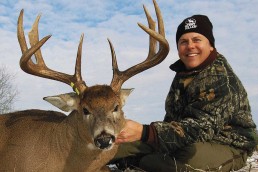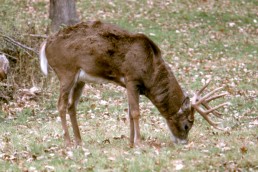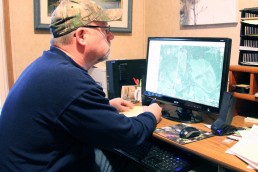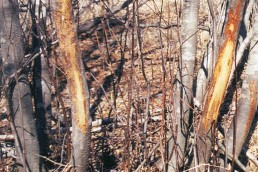Barometric Pressure and Whitetail Movement
SHARE THIS POST
Back in the ‘90s, I was involved in a study we called the “W.M.W.M. Study” (What Makes Whitetails Move). The results of the study was to be fodder for a book and video, but those involved all had a more jealous motive—we wanted to know under what conditions proved best for seeing more deer and harvesting mature bucks. While any day has the potential for yielding a successful hunt, I wanted to maximize my time.
We documented statistics such as temperature, wind direction and speed, lunar phase, moon position, cloud cover, precipitation, relative humidity and barometric pressure. We took these readings when we began our observations, and then again when we finished just in case there were any significant changes. We recorded how many whitetails we saw, what activity they were engaged in (feeding, chasing, traveling, breeding, etc.) and when it happened and how long it lasted. We also had two unmolested, private, captive “control-whitetail herds” that could be witnessed at any time to give us something to weigh against our “wild findings.” We hoped that we would find the mysterious combination of factors to give us an edge in the treestand.
Understand, this was before trail cameras and smartphones; we wrote our notes down on paper with pencil. We collected data for seven years, however I have continued on gathering this information for my own benefit. And since the onslaught of new technology, it’s so much easier. Nowadays it’s definitely effortless to collect data and record it, but the findings are similar.
While there is a “comfort zone” with each of the phenomenon we recorded—the amount of light the moon put off combined with the amount of cloud cover because deer don’t travel as much when it’s too hot, too cold, or when windy or when raining/snowing, etc.—the barometric pressure had more influence than any other occurrence.
In my view, no other aspect of the weather has as big an influence on deer movement as the atmospheric pressure, or barometric pressure. Whitetails have the ability to sense these changes. A barometer is the instrument that measures the amount of air pressure exerted by air molecules against the earth’s surface. It’s the increase, decrease or stabilization of this pressure that affects deer behavior, sometimes greatly.
Many of you may have witnessed this escalation or decline in deer movement and were confused. We’ve all had days, even a week or more you’d have to admit, when it was tough and deer sightings were rare. If you hunt long enough you’ll definitely experience a lull caused by this pressure change. Then, all of a sudden, deer appear as if God opened up the “drain plug” on a “sinkful” of whitetails and deer are everywhere. Unfortunately, they can mysteriously vanish again just as abruptly.
It’s not hocus-pocus; it’s atmospheric air density that triggers this activity. It’s the rapidly rising or declining barometric pressure that precedes or follows a weather front that seems to show the biggest impact. Anytime the barometer is moving you want to be in the woods.
You may have heard your news weatherperson mention the terms “low pressure” or “high pressure” and refer to increased or decreased barometric pressure associated with a weather system. If the air molecules above the earth’s surface are not as dense, the result will be a decrease in barometric pressure. The resulting low-pressure system is known to usher in clouds and precipitation. A high-pressure system on the other hand, produces a dense atmosphere with clear conditions and produces few clouds, low humidity and fair weather.
Are you enjoying this post?
You can be among the first to get the latest info on where to go, what to use and how to use it!
A whitetail’s inner ear works very much the same as a barometer. In fact, it’s said that in ancient times man also had the ability to better “sense” these changes. Our modern problem being, if you’re watching your barometer at home, you’re too late. Instead, you must anticipate the movement by predicting when weather fronts will arrive and leave your hunting area. On the leading edge and tail edge of the front the barometer will fall or rise—that’s when you want to “be in the tree.”
After compiling our results, whitetails seem to move best when the pressure is between 29.90 and 30.30 inches or millibars (mb), with the best movement occurring at the higher end of that range, around 30.10 to 30.30 inches. I’ve also seen this with mule deer and pronghorn and many other animals may be sensitive to the changes.
Many of the high-pressure fronts will come with wind. Numerous trophies are shot immediately after sustained high winds have died down. I’m not sure if whitetails are just avoiding the nor’easter-type winds or sensing the barometric change, or both.
Keep in mind you must also have other factors in your favor—or more so your deer herd’s favor—if you wish to see the barometric pressure’s influence. If the temperature is outside their comfort range or hunting pressure keeps them bedded, the impact won’t be as significant. Molested whitetails aren’t going to want to move during light no matter what their built-in barometer tells them.
Whitetails and other animals sensing the change in barometric pressure is likely Mother Nature’s way of protecting the herd. The pressure changes tell the animals they may have to bed down for a period, so they better “put on the feed bag” or finish whatever activity they’re involved in before the approaching weather front arrives.
In my opinion, the biggest impression can be seen in the North just before and just after a major snowstorm or blizzard. If you can’t predict when this will happen or watch a weather forecast before the front hits, make certain to be in your treestand when the storm breaks—activity is all but guaranteed.
Remember that barometric pressure is only one contributing factor to deer movement. In my view, it is one of the most important elements and should not be overlooked. However, it’s really a combination of factors that all contribute to deer movement. Keep an eye on the barometer, but don’t use it as your only way to predict your herd’s activity.
MWO
SHARE THIS POST
Did you enjoy this post?
You can be among the first to get the latest info on where to go, what to use and how to use it!
Todd Amenrud
Todd Amenrud is a full time sportsman whose passion is bowhunting whitetails. He spends considerable time researching whitetails, and has written six books on the subject. Harvesting 47 record-book animals and his ability to share his knowledge have made him one of the Midwest’s most-recognized hunting resources.



